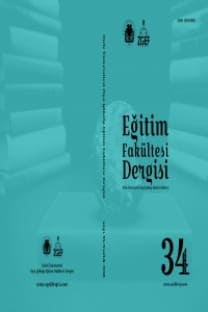Atom, İyon, Molekül ve Madde Kavramlarının Öğrenilmesinde Kavramsal Değişim Metinlerinin Etkisi
Kavramsal Değişim Metinleri, Analoji, Kavram Yanıgıları, Fen Bilgisi Tutum Ölçeği
FACILITATING CONCEPTUAL CHANGE IN ATOM, MOLECULE, ION AND MATTER COCEPTS
Conceptual Change Text, Analogy, Misconception, Attitude Toward Science,
___
- Anderson, C. W., Smith, E. L. (1983). Childerens’ preconceptions ad content area textbooks. In G. Duff, L. Rochler, J. Mason (Eds.), Comprehension instruction: Perspective and suggestions. New York: Longman, 187-201.
- Ayas. A. & Ozmen, H. (2002). Students’ misconceptions about chemical reactions at secondary level. The First International Education Conference on Changing Times, Changing Needs, Eastern Mediterranean University Faculty of Education, Gazimagusa, Turkish Republic of Northern Cyprus.
- Bodner, G. M., (1986). Constructivism: A Theory of knowledge, Journal of Chemical Education, 63, 873-878.
- Boo, H. K. (1998). Students’ understanding of chemical bonds and the energetic of chemical reactions. Journal of Research in Science Teaching, 35, 569–581.
- Blanco, A. & Prieto, t. (1997). Pupils’ views on how stirring and temperature affect the dissolution of a solid in a liquid: a cross-age study (12 to 18). International Journal of Science Education, 19, 303-315.
- Chambers,S. K. & Andre, T. (1997). Gender, prior knowledge, interest, and experience in electricity and conceptual change text manipulations in learning about direct current. Journal of Research in Science Teaching, 34(2),107-123.
- Chiu, M.H. (2005). A national survey of students’ conceptions in chemistry in Taiwan. Chemical Education International. 6(1), 1-8.
- Coll, R.K. & Taylor, N. (2002). Mental models in chemistry: Senior chemistry students’ mental models of chemical bonding. Chemistry Education: Research and practice in Europe, 3, 3.
- Duit, R. (1991). On the role of analogies and metphors in learning science. Science Education. 75, 649-672.
- Geban O., Ertepınar, H., Yılmaz, G., Atlan, A. & Şahbaz, O. (1994). Bilgisayar destekli eğitiminin öğrencilerin Fen Bilgisi başarılarına ve Fen Bilgisi bilgilerine etkisi. I. Ulusal Fen Bilimleri Eğitimi Sempozyumu, Dokuz Eylül Üniversitesi.
- Gilbert, J., Osborne, R. and Fensham, P. (1982). Children’s science and its consequences for teaching. Science Education, 66, 623-633.
- Harrison, A.G. and Treagust, D.F. (1996). Secondary students’ mental models of atoms and molecules: Implications for teaching chemistry. Science Education. 80 (5), 509-534.
- Hein, G.E. (1991). Constructivist learning theory: The museum and the needs of people. Paper prented at the CECA conference, Jerusale, Israel.
- Heywood, D. (2002). The Place of Analogies in Science Education.Cambridge Journal of Educarion,32 (2), 233-247.
- Hynd,C. R., McWhorter,I. Y., Phares,V. L. & Suttles, C. W. (1994). The role of instructional variables in conceptual change in high school physics topics. Journal of Research in Science Teaching, 31(9), 933-946.
- Hyde, A.A. and Bizar, M. (1989). Thinking in context: Teaching cognitive process across the elementary school curriculum. White Plains, New York: Longman.
- Novick, S., & J. Nussbaum. (1982). Brainstorming in the classroom to invent a model: a case study. School Science Review, 62, 771-778.
- Lee, O., Eichinger, C.D., Anderson, W.C., Berkheimer, D.G.,& Blakeslee, T.D.(1993). Changing middle school students’ conceptions of matter and molecules. Journal of Research in Science Teaching, 30(3), 249- 270.
- McCloskey, M., (1983). Intuitive physics. Scientific American, 248, 122-130.
- Nakhleh, M. B. (1992). Why some students don’t learn chemistry? Chemical misconceptions. Journal of Chemical Education 69: 191–196.
- Novick, S. and Nussbaum, J. (1978). Junior high school pupils’ understanding of the particulate nature of mater: An interview study. Science Education, 62 (3), 273-281.
- Pabuccu, A. & Geban, Ö. (2006). Remediating misconceptions concerning chemical bonding through conceptual change text. Hacettepe University Journal of Education, 30, 184-192.
- Posner, G. J., Strike, K. A., Hewson, P. W., and Gertzog, W. A. (1982). Accommodation of a scientific conception: Towards a theory of conceptual change. Science Education 66: 211–217.
- Rule, A.C. & Furletti, C. (2004). Using form and function analogy object boxes to teach human body systems, School Science and Mathematics, 104, 155-169.
- Taber, K. S., & Watts, M. (1997). Constructivism and concept learning in chemistry- perspective from a case study. Rearch Education, 58, 10- 20.
- Taylor, J.A. (2001). Using a particial context to encourage conceptual change: An instruction sequence in bcycle science. School Science & Mathematics, 101 (2), 91-102.
- Tekkaya, C. (2003). Remediating high school students' misconceptions conceming diffusion and osmosis through concept mapping and conceptual change text. Research in Science & Technalogical Education, 21(1), 5-16.
- Osborne, R. I. & Wittrock, M. C. (1983). Leaming science: A generative process. Science Education, 67(4),489-508.
- Yanowitz., K.L. (2001). Using analogy to improve elementary school student’ inferential reasoning ability about scientific concepts. School Science & Mathematics, 101 (3), 133-142.
- ISSN: 1305-0060
- Yayın Aralığı: Yılda 2 Sayı
- Başlangıç: 1995
- Yayıncı: Dicle Üniversitesi
SINIF YÖNETİMİNİN ETKİLİLİĞİNİ ETKİLEYEN FAKTÖRLERE İLİŞKİN OKUL MÜDÜRLERİNİN GÖRÜŞLERİ
Şahin GÖKÇEARSLAN, Abdullah DURAKOĞLU
VATANDAŞLIK VE DEMOKRASİ EĞİTİMİ DERSİNE YÖNELİK TUTUM ÖLÇEĞİ; GEÇERLİK VE GÜVENİRLİK ÇALIŞMASI
Selçuk Beşir DEMİR, Murat BOZBEK
İLKÖĞRETİM ÖĞRETMENLERİNİN ÖĞRETİM STİLLERİNİN ÇEŞİTLİ DEĞİŞKENLER AÇISINDAN İNCELENMESİ
Dilek Çağırgan GÜLTEN, Ekrem ÖZKAN
MATEMATİK ÖĞRETMEN ADAYLARININ MATEMATİKSEL MODELLEME BECERİLERİNİN İNCELENMESİ
